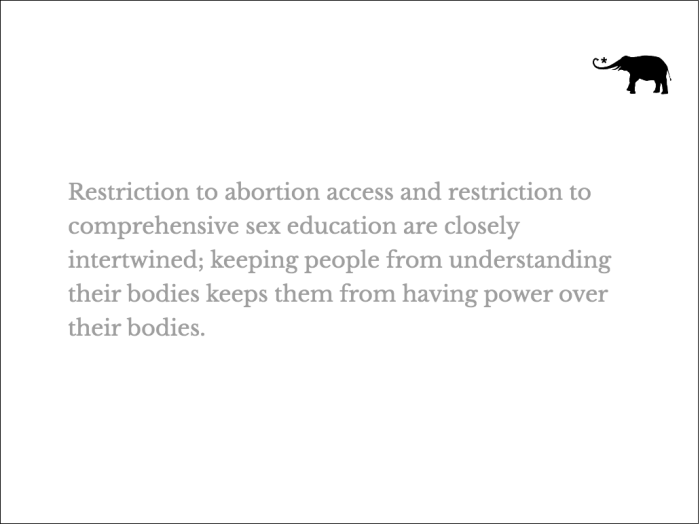Discussions around reproductive rights and education have only become more common and more urgent since the overturning of Roe v. Wade in June 2022. As the United States (U.S.) reckons with new restrictions on rights to body autonomy and the subsequently emerging health consequences, it’s important to consider how our public education system, particularly one which does not prioritize comprehensive sex education, may play a crucial role in the battle.
In the U.S. there is no federal legislation that dictates sex education, and therefore it is mostly left up to state and local regulations. There are 39 states and the District of Columbia that require HIV prevention or some form of sex education to be taught in schools; however, there is no requirement on the quality of education, and fewer than half of these states require the materials to be medically accurate.
In the year since Roe v. Wade was overturned, 13 states have completely banned abortion and 13 others have restricted or severely restricted access. Laws change quickly, so get the most up to date facts on abortion access here.
Restriction to abortion access and restriction to comprehensive sex education are closely intertwined; keeping people from understanding their bodies keeps them from having power over their bodies.
Learning about sexual health and our reproductive systems are vital for healthy living. It touches every aspect of our lives: from disease prevention to mental health promotion, topics about sex are inescapable and intricately woven into everything we do. Sex is a social phenomenon, an emotional experience, and a physical manifestation of our bodies’ most basic job and natural instinct. When we talk about sex, we want to think about pleasure, erotica, orientation and desire, or disease transmission and possible pregnancy, but we also must consider the hormones at play, the mental and emotional response from our bodies, and how all of this makes us more or less vulnerable to our cultures’ rules and regulations.
More distinctly, comprehensive sex education can equip people with the knowledge they need to help protect themselves from the restrictive burdens of abortion policy in the U.S. today.
While there are a number of important topics to cover in sex education curricula, menstruation is one that doesn’t get the attention it deserves. Menstruation is a hormonal cycle that makes pregnancy possible in people with ovaries and a uterus. Most young people who are getting their periods or exposed to sex education for the first time won’t learn much more than that they will bleed once per month and will need to use a pad or tampon to absorb the blood. But understanding the nuances of the menstrual cycle opens the door to mental and emotional wellbeing, social and physical comfort, empowerment through knowledge, and potentially the ability to avoid or become pregnant.
The four phases of the menstrual cycle each have different dominant hormones and common symptoms that people may experience. By understanding the fluctuations of these phases, people can be more aware of how to nourish their bodies according to their hormonal rhythms; furthermore, understanding this cycle can help those capable of pregnancy strategize to maintain body autonomy.
Strategically speaking, there is a window of about 4 days when someone who menstruates is capable of becoming pregnant. If people understand when their fertile window is and use contraceptives during this time, they are unlikely to experience unintended pregnancy. Moreover, in some states, understanding this information could mean the difference between obtaining an abortion and being denied.
When someone’s pregnancy is verified by a medical provider, their gestational age is measured by their last menstrual period, or LMP. The provider will note the first day of someone’s LMP, and count the number of weeks and days until the current date to get the gestational age. So for example, if someone has a 28 day cycle and their LMP was July 1st, and today’s date is August 14th, they would be considered six weeks and two days pregnant.
But let’s break this down. The pregnancy didn’t occur on the day of their last period (July 1st), because they wouldn’t ovulate and be capable of pregnancy until around day 14 (July 14th). So if we measured gestational age by the date of ovulation, which is when a pregnancy could actually occur, then it would be four weeks and two days, a full two weeks under the cutoff for an abortion in several U.S. states.
Of course, legislators are aware of this, and abortion laws in the U.S. only reflect the nation’s incompetent understanding of the menstrual cycle. It’s unrealistic to think that people understanding this information will necessarily change laws or allow them to advocate for themselves in a restrictive state, but it will give people the power of knowing their bodies and acting fast if they need to.
Menstrual irregularities such as polycystic ovarian syndrome (PCOS), amenorrhea, and others occur in roughly 14% to 25% of menstruating people, making them even more vulnerable to abortion restrictions than folks with regular, predictable cycles. Marginalized communities, especially black and brown people, as well as trans and genderqueer folks are also more vulnerable to increased restrictions in an already discriminatory environment. Increased access to comprehensive sex education is a step towards equipping folks with the tools they need to feel empowered and autonomous over their bodies and healthcare decisions.
High quality sex education that covers the menstrual cycle in detail is not a solution to the abortion problem, but rather, the lack of it is part of the problem. When people don’t know what’s going on with their bodies, they’re less able to plan, advocate, and take action to protect their health and wellbeing.
References:
- Sex education laws and state attacks. Accessed August 16, 2023. https://www.plannedparenthoodaction.org/issues/sex-education/sex-education-laws-and-state-attacks
- Where is abortion illegal? | abortion limits by state. Accessed August 21, 2023. https://www.plannedparenthoodaction.org/abortion-access-tool/US
- What are menstrual irregularities? | nichd – eunice kennedy shriver national institute of child health and human development. Published January 31, 2017. Accessed August 14, 2023. https://www.nichd.nih.gov/health/topics/menstruation/conditioninfo/irregularities












Read 0 comments and reply